All you need is a few simple ingredients to make these delicious and soft sourdough discard English muffins. Delightfully chewy, this recipe makes the perfect breakfast, brunch, or even use them in place of bread in sandwiches.
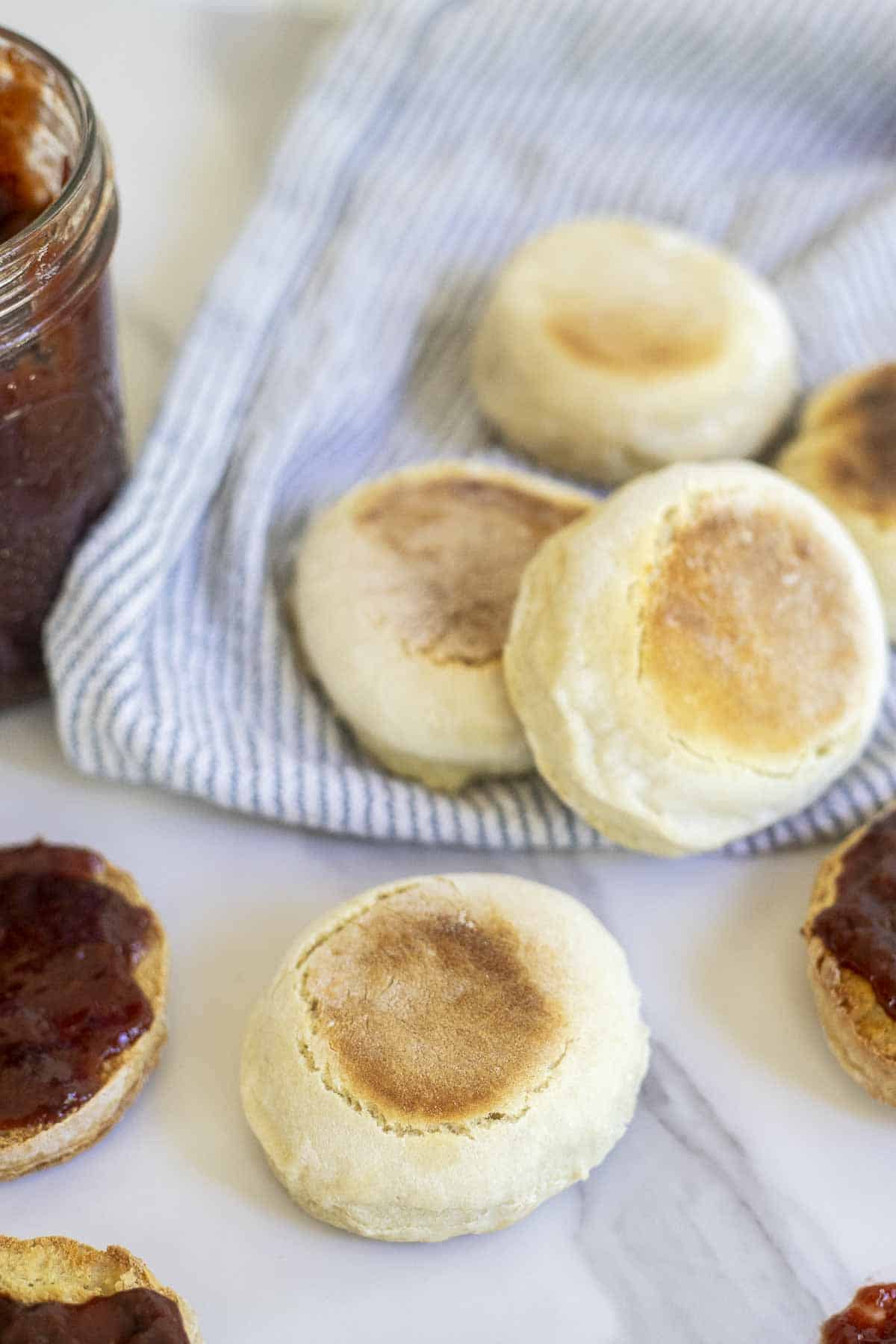
This post contains affiliate links, which means I make a small commission at no extra cost to you. See my full disclosure here.
The original version of my sourdough English muffins were one of my very first sourdough recipes on the blog. They are a staple in our house. They are super simple to make, they come together quickly, and you can use them in just about a thousand ways.
Most of the ingredients you probably already have in your pantry, and if you are new to sourdough baking, this is for you.
Sourdough bread can be intimidating. You worry about the timing, and about feeding your starter so it is active when you are ready to start the dough. It’s one reason many people don’t even try. They are overwhelmed with all the new things they may have to learn.
If that is you, I want to encourage you to keep going. Start with sourdough discard recipes, like double chocolate sourdough bread, and once you get your feel for it, move on to some active starter fermentations.
Why You’ll Love This Recipe
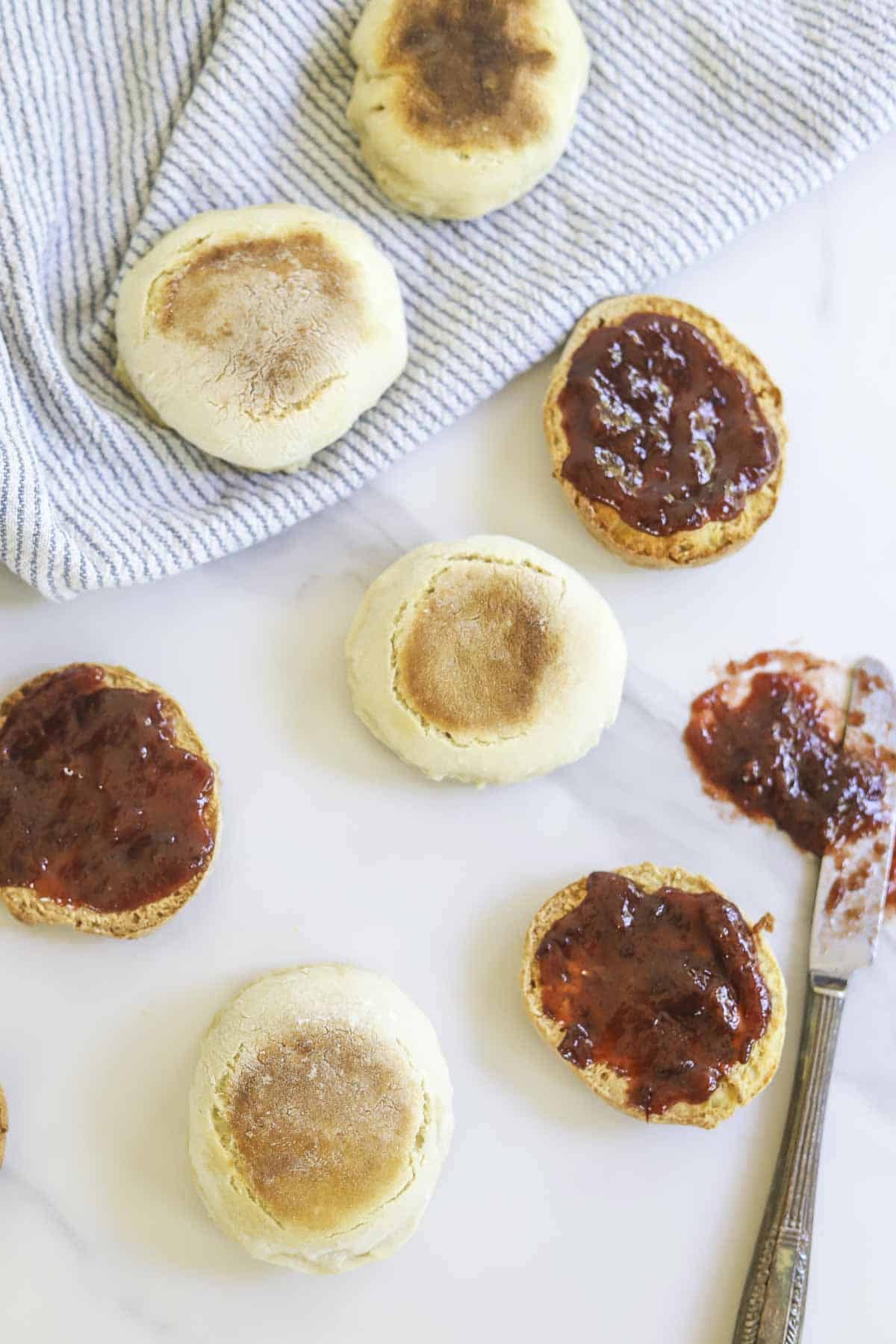
Great way to use discard: No, you don’t need an active sourdough starter for this recipe (although that will work). Discard will work just fine because the dough is risen by baking soda rather than the wild yeast in the active starter.
Versatile: English muffins can be used in a variety of ways– no need to stick to just breakfast. I use them for sandwiches or even as a side instead of biscuits. Slather on some homemade strawberry jam or cream cheese and everyone will be happy.
Super simple: They can be made quickly or long-fermented for the added health benefits.
Ingredients
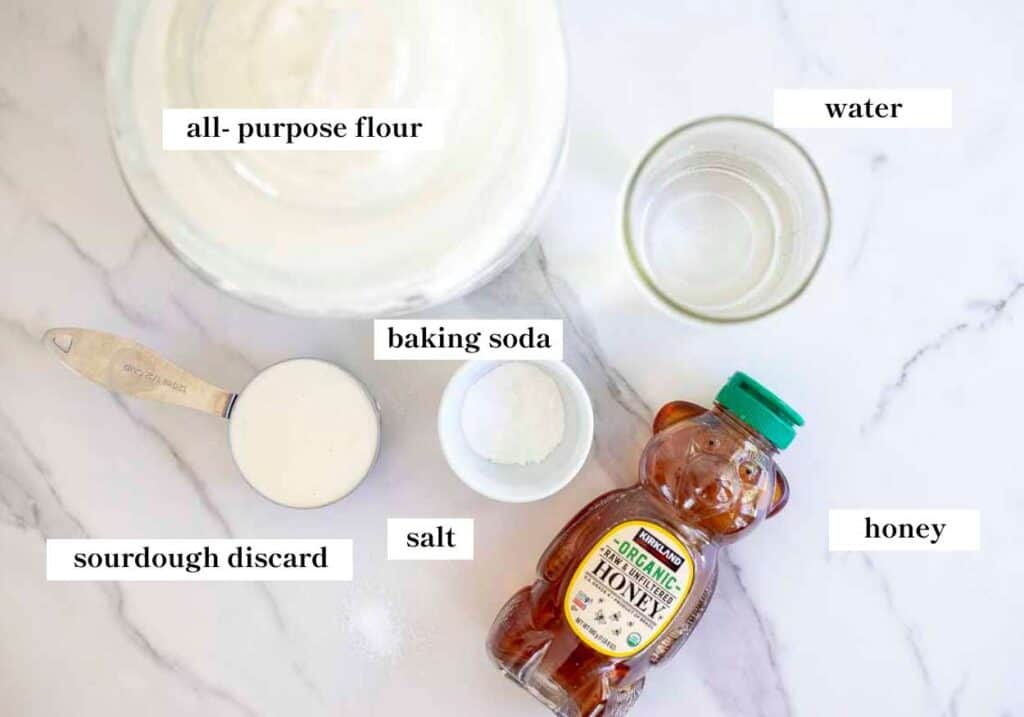
Sourdough discard: The star of the show. This is an unfed sourdough starter. Active starter will also work, but it’s not a requirement. Discard also adds a lovely tanginess to the dough. Learn how to make a sourdough starter.
Honey: You could also use maple syrup or even sugar. You may need to add a little water if using sugar.
Baking soda: This gives the dough its rise.
Tools You May Need
Cast iron skillet
English muffin rings, biscuit cutter, round cookie cutter, or even just a mason jar ring
How to Make Sourdough Discard English Muffins
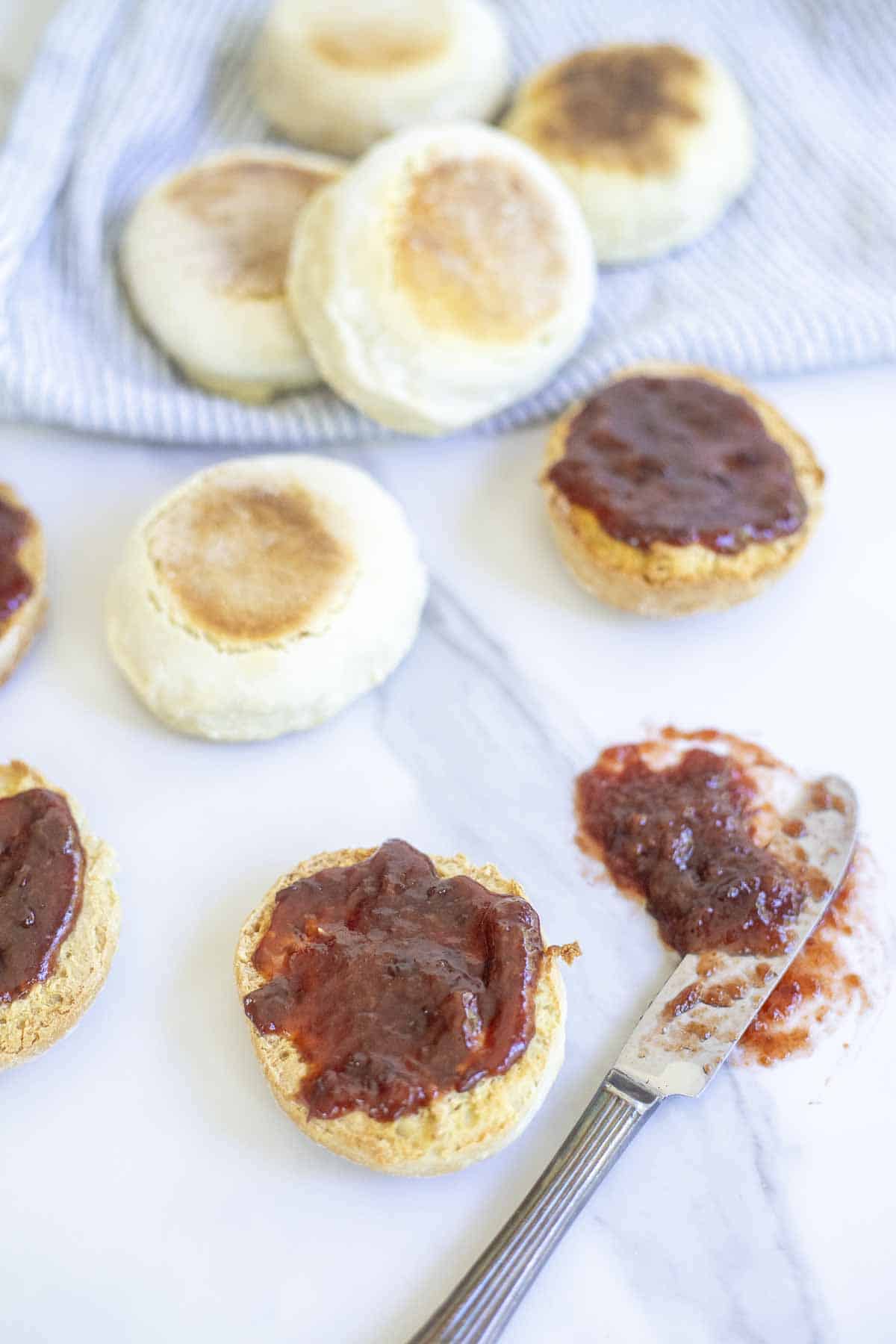
The Quick Version
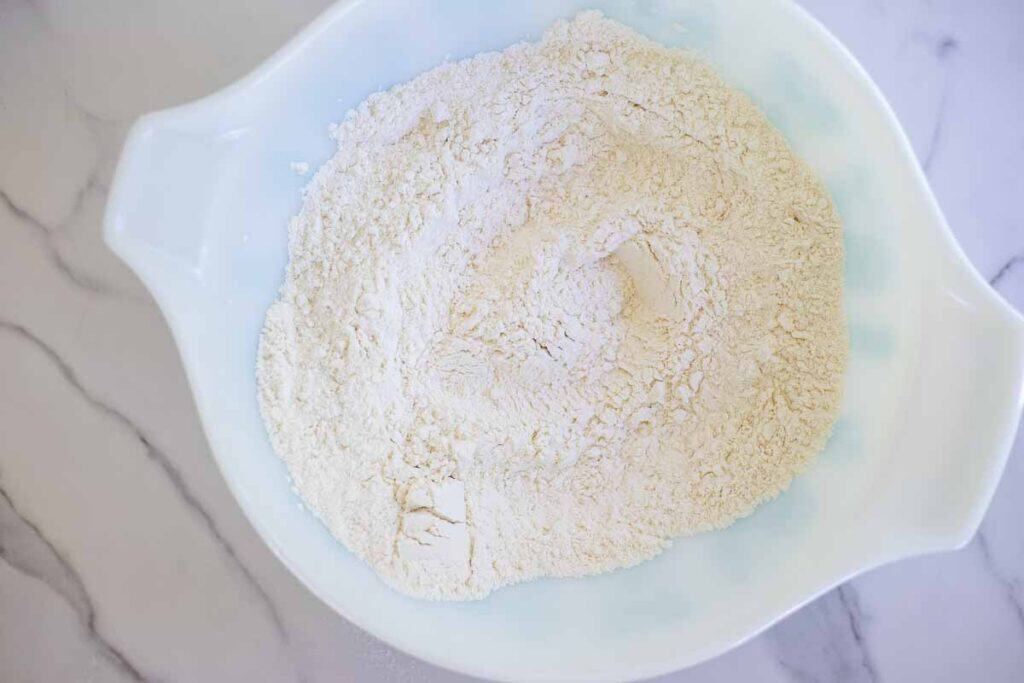
Step 1: Heat a large cast iron skillet over medium-low heat. Add flour, salt, and baking soda to a large bowl. Whisk together well.
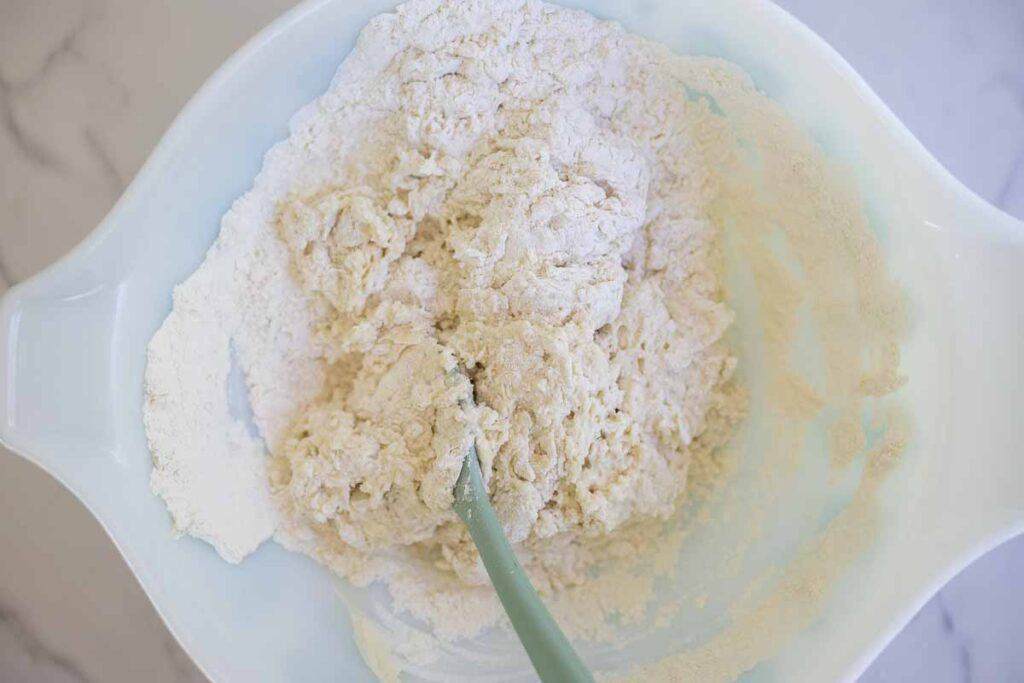
Step 2: Add in water and sourdough starter discard. Mix until it comes together. You could use a stand mixer if you prefer.
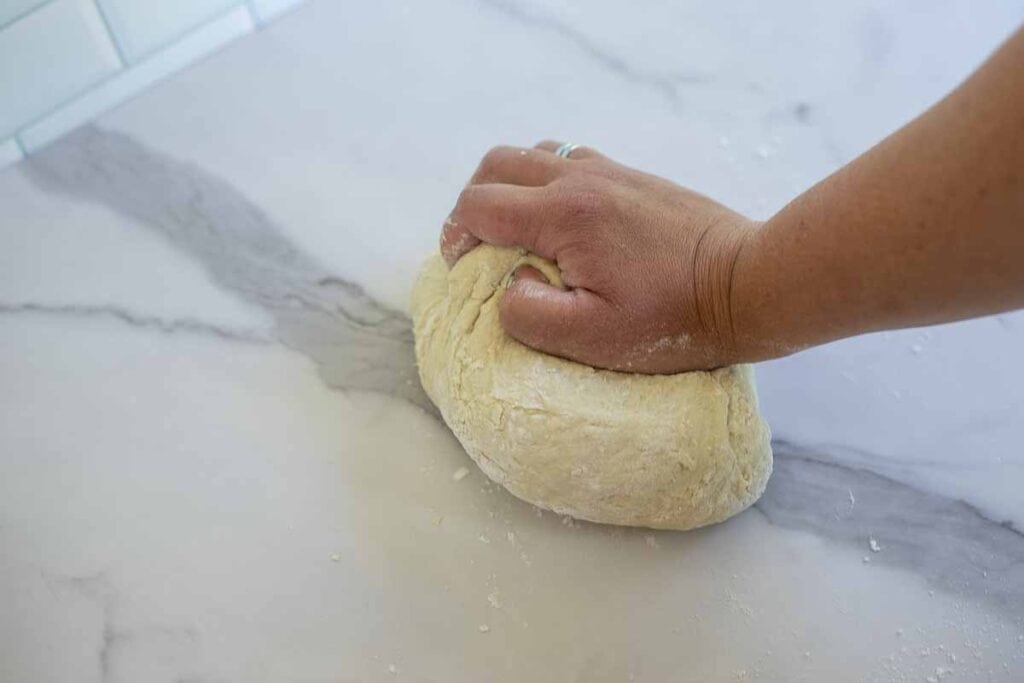
Step 3: Knead the dough for a few minutes to help develop the gluten strands.
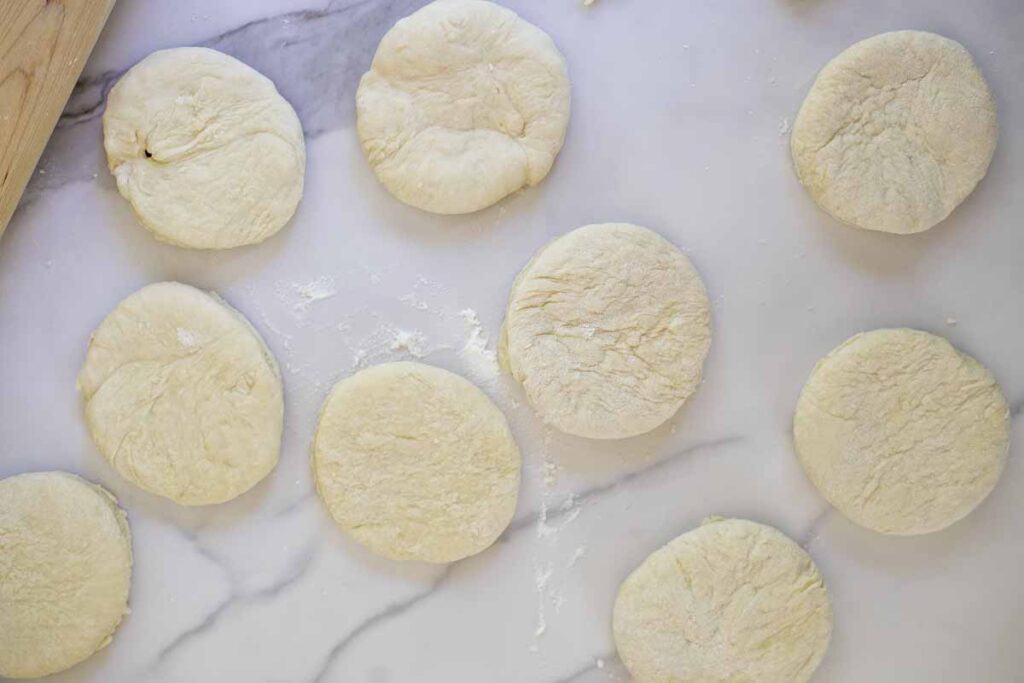
Step 4: Roll dough out on a lightly floured surface about 1/2 inch thick with a rolling pin. Use an English muffin cutter and cut out the dough. Continue rolling out and cutting dough until all the dough is used up.
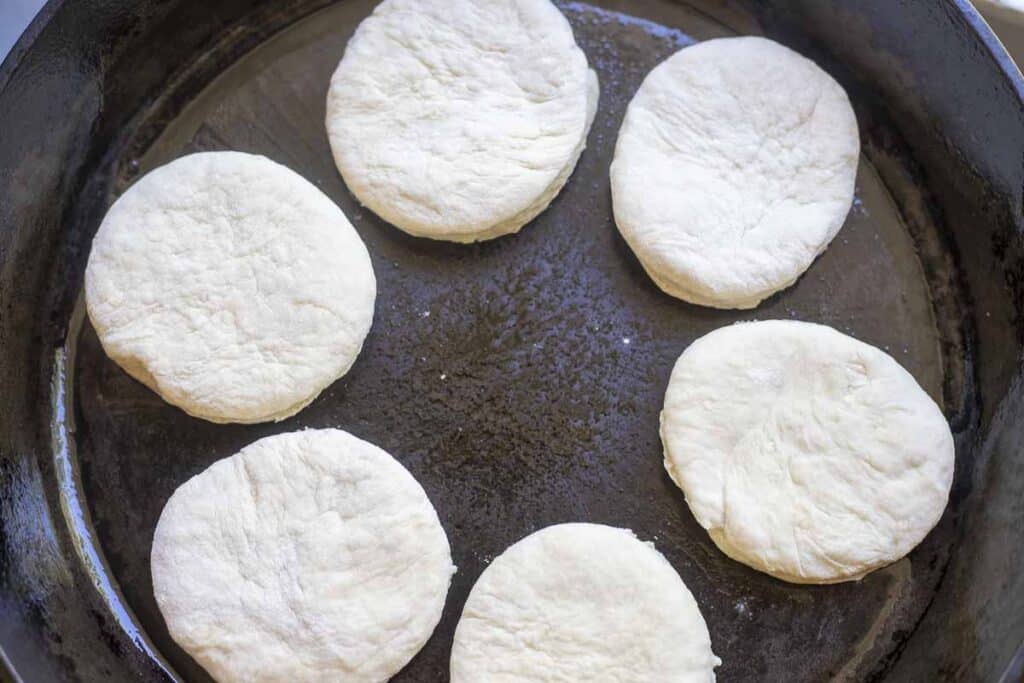
Step 5: Add a little oil to the cast iron skillet. Place English muffins in the pan. Allow to cook for about 5-6 minutes on one side.
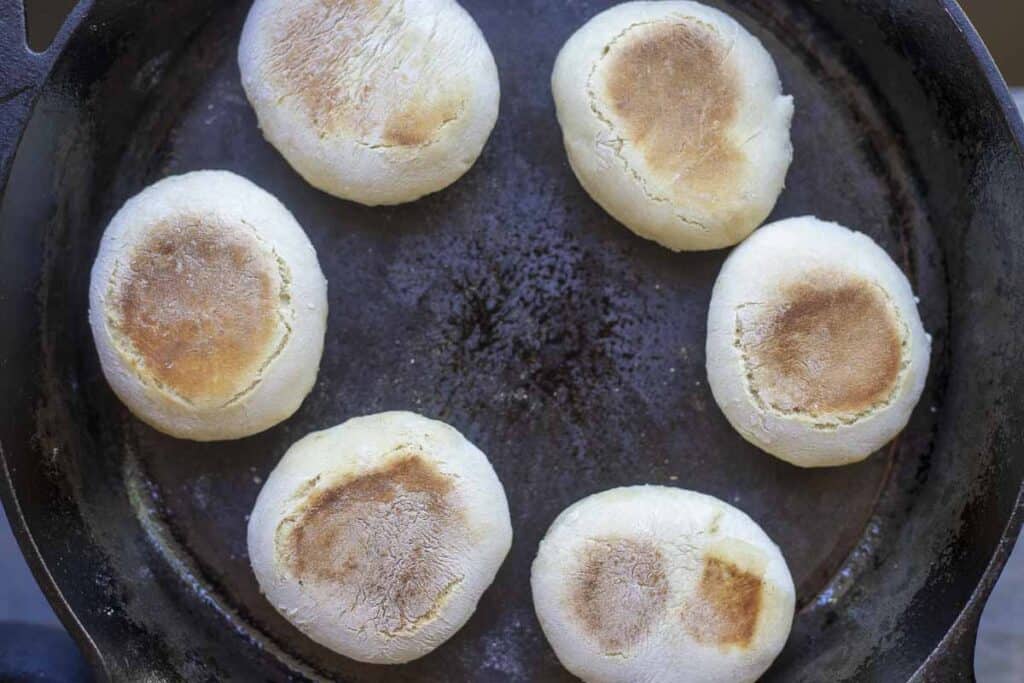
Step 6: Flip and continue cooking for another 5-6 minutes. Allow to cool, then serve. If they have not cooked all the way through, place them in a 350 degree oven for a few minutes.
The Long-Fermented Version
Step 1: In a large bowl, mix all of the ingredients minus the baking soda. Knead together for a few minutes. Cover with plastic wrap or a lid and allow to sit at room temperature for 8-12 hours.
Step 2: The next day, add baking soda to the fermented dough and knead well, making sure it’s all incorporated. Roll the dough and cut out. Preheat the skillet on medium-low heat.
Step 3: Add the English muffins to the cast iron skillet. Cook for about 5-6 minutes on one side, then flip and continue cooking for another 5-6 minutes. Allow to cool, then serve.
Tips
- If your dough is too dry, you may need to add a little more water. The hydration of your starter will play a big part in this.
- If you find that the homemade English muffins are not cooking all the way through, you may need to pop them into a 350-degree Fahrenheit oven and allow them to finish cooking.
- Make sure to use fresh baking soda for best results. Old baking soda may not give these muffins the desired rise.
- If making the long-fermented version, the dough may not rise at all during the fermentation period and that is totally fine. Nothing to worry about!
Recipe FAQ
Yes. They are made with a few basic ingredients and can be a healthy part of your diet. Long-ferment them for even more health benefits.
Yes. It is an active living food with fermented grains and healthy yeasts and bacteria.
Using sourdough discard can be a great way to reduce food waste rather than just tossing it out. It can also ferment grains just like an active starter, it just may not rise the dough.
Once your sourdough starter is established and you are using it frequently, you don’t need to discard every time. But if you find that you have too much starter, I would recommend discarding it to keep it a healthy and manageable size.
Storage
Store in an air-tight container for up to five days. Freeze for up to 3 months.
Pair this recipe with:
- Zucchini Frittata
- Over-hard Eggs
- Peach Preserves
- Homemade Ricotta or Kefir Cheese
- Ham and Cheese Frittata
- Or turn them into Sourdough Breakfast Sandwiches
- Sourdough Beignets
If you make this recipe and love it, I would love if you gave it 5 stars! Tag me on Instagram @farmhouseonboone with your delicious creation.
Sourdough Discard English Muffins
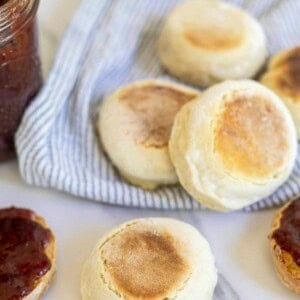
Ingredients
- 2 1/2 cups flour, 350 g
- 1 cup water, 236 g
- 1/2 cup sourdough discard, 125 g
- 1 tablespoon honey, 21 g
- 1 teaspoon salt, 5 g
- 1 teaspoon baking soda
Instructions
- Heat a large cast iron skillet over medium-low heat.
- Add flour, salt, and baking soda to a large bowl. Whisk together well.
- Add in water, sourdough starter discard, and honey. Mix until it comes together. You could use a stand mixer if you prefer.
- Knead the dough for a few minutes to help develop the gluten strands.
- Roll dough out on a lightly floured surface about 1/2 inch thick with a rolling pin.
- Use an English muffin cutter and cut out the dough. Continue rolling out and cutting dough until all the dough is used up.
- Add a little oil to the cast iron skillet. Place English muffins in the pan. Allow to cook for about 5-6 minutes on one side, then flip and continue cooking for another 5-6 minutes. Allow to cool, then serve.
Notes
- If your dough is too dry, you may need to add a little more water. The hydration of your starter will play a big part in this.
- If the English muffins are not cooking all the way through, you may need to pop them into a 350-degree Fahrenheit oven and allow them to finish cooking.
- Make sure to use fresh baking soda for best results. Old baking soda may not give these muffins the desired rise.
- If making the long-fermented version, the dough may not rise at all during the fermentation period and that is totally fine. Nothing to worry about!
- See post for long fermentation directions.
Nutrition
Nutrition information is automatically calculated, so should only be used as an approximation.

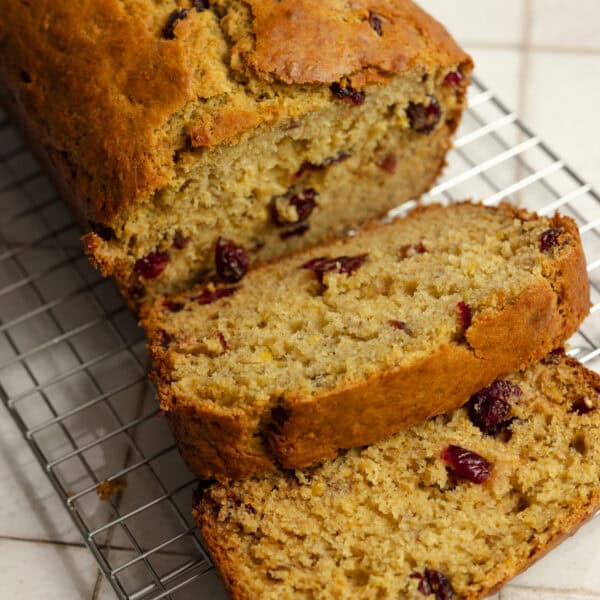
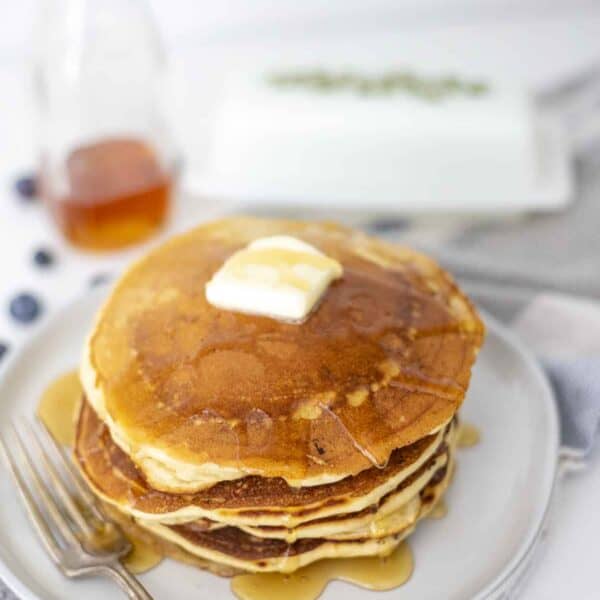
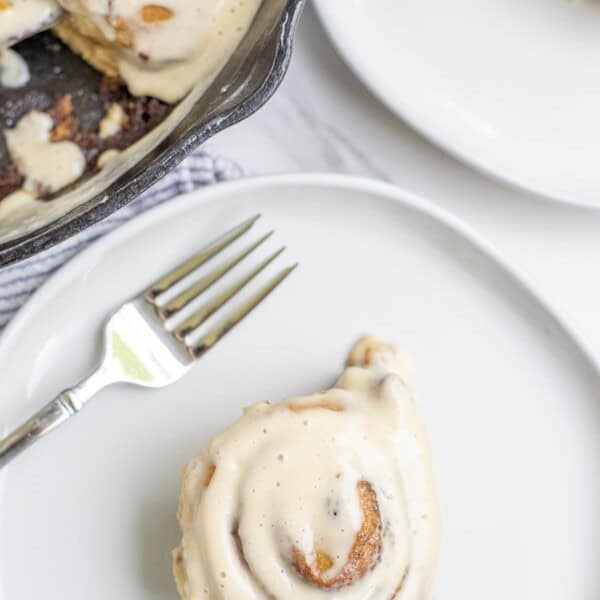






These English muffins are biscuit-like. I use a fully active starter instead of discard. They don’t have large pockets like you’re used to, but they’re delicious. I feel as though the recipe doesn’t specify how much kneading is required. This dough is very sticky. It’s going to be ALL over your hand, but with good amount of kneading it tightens up, becomes more workable and dough like. I’d say I end up working it pretty aggressively for between 5-10 minutes. You can tell it’s coming together because it gets more elastic and holds together better. I only use the long ferment method, and it hasn’t failed me yet. I prep it before bed and finish in the morning. I lightly coat the dough with corn starch so it doesn’t stick to my work surface, and it gives it that lovely texture that most English muffins have. I’ve yet to find the perfect bake time to completely cook the inside, but they’re still really good with a little butter, even if they’re a little soft. They toast well and make good sandwiches. I just wish they were slightly more bubbly.
I personally wouldn’t waste my time with this one. I followed the measurements by weight, used my discard that had same consistency as my healthy fed starter.
The dough was so wet and sticky it was unworkable, I had to add a good amount of flour to get it workable.
Then they didn’t rise at all, we even let a handful rise for about 2 hours, came out super stodgy.
Either the directions are terrible or the recipe is. Either way I won’t be trying this one again.
I am sorry you did not find success with this recipe.
Hi! What could I substitute for honey so my 9 month old can eat these?
Sugar or you could omit the sweetness.
Just tried these, very confused. I followed the recipe to a T and they ended up looking like bisquits and are very very dense. Where did I go wrong?
More like a biscuit ro me than an English muffin. Still doughy and not appetizing. I feel like I wasted my ingredients.
this was so easy! First time ever to make something like this and I feel accomplished!
Turned out perfect!🙂
I followed this recipe 3 x and they did not get much of a rise at all and looked like discs. i am very disapointed in this recipe.
They turned out ok. I used virgin oil but next time may try coconut or avocado. I thought they would be lighter and airier. I did not have. good cutter so I ordered one and will see when that comes and they are little more uniform. I will also let them cook a bit in the oven. The insides were a little mushy.
Turned out okay, glad to have something to use my discard for. I didn’t I will make this again with one of a few changes:
– This dough turned out unworkably wet at the weights recommended, and that’s with pretty stiff discard. I ended up adding something like 40 grams extra flour. Next time I’ll start by mixing everything but the water (and baking soda, see below), then adding water incrementally until the dough comes together.
– I got a nice rise out of the muffins but unfortunately the inside was still quite dense. I didn’t get many of the nice cavities I hope for in an English muffin. I’m concerned that I didn’t catch the baking soda’s chemical reaction with the acidic honey and starter because I was busy mixing flour into my wet, wet dough. So next time I think I’ll try adding the baking soda just before rolling out.
I also think I rolled them out too thick, which probably influenced the rise and density. So that’s something to fix for next time too.
I know that’s a lot of complaints but this is baking — the first batch is gonna be weird.
My dough was also incredibly wet! I had to add another cup of flour!!! My starter isn’t super stiff but not super wet either, somewhere in between.
I got a lovely rise out of them in the pan but no pockets. Very dense but light like a biscuit rather than an English muffin. Very first time making this recipe & I’m new to sourdough also. I figured it was just me!